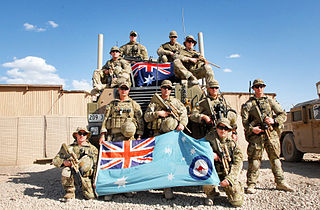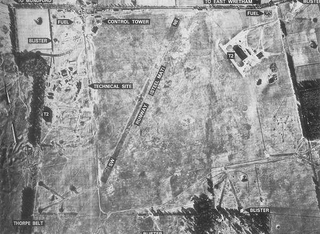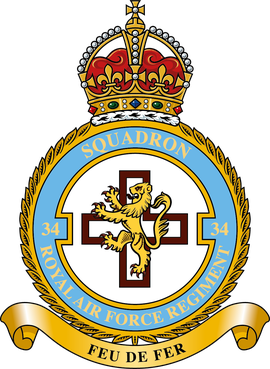
Airfield Defence Guards (ADG) are a mustering of the Royal Australian Air Force (RAAF) that are dedicated to the security and ground defence of airbases and other military aviation assets. Other duties include training other RAAF personnel, in skills such as the handling of small arms and infantry tactics. They do not, however, operate anti-aircraft artillery or missiles.

The Army Air Corps (AAC) is the aviation arm of the British Army, first formed in 1942 during the Second World War by grouping the various airborne units of the British Army. Today, there are eight regiments of the AAC, as well as two independent flights and two independent squadrons deployed in support of British Army operations around the world. Regiments and flights are located in the United Kingdom, Kenya, and Canada. Some AAC squadrons provide the air assault elements of 16 Air Assault Brigade Combat Team, through Joint Aviation Command.

Royal Air Force Akrotiri, commonly abbreviated RAF Akrotiri is a large Royal Air Force (RAF) military airbase on the Mediterranean island of Cyprus. It is located in the Western Sovereign Base Area, one of two areas which comprise Akrotiri and Dhekelia, a British Overseas Territory, administered as a Sovereign Base Area.

Number 8 Squadron of the Royal Air Force last operated the Boeing E-3D Sentry AEW1 (AWACS) from RAF Waddington, Lincolnshire. As of 2020, the RAF AWACS fleet was made up of three Sentry AEW1s, down from seven originally ordered in the late 1980s. Pursuant to the 2021 defence review, the E-3D Sentry aircraft made its final flight in U.K. service in August 2021.

The Royal Air Force Regiment is part of the Royal Air Force and functions as a specialist corps. Founded by Royal Warrant in 1942, the Corps carries out basic soldiering and security tasks relating to the [protection of] delivery of air power. Examples of such tasks are non-combatant evacuation operation (NEO), recovery of downed aircrew, defence of airfields by way of aggressively patrolling and actively seeking out infiltrators in a large area surrounding airfields. The key tenet of the RAF Regiments role is based around defensive security operations, rather than the Army’s more traditional offensive infantry role, which is to close with and kill the enemy; notwithstanding, this does require active patrolling outside the Airfield perimeter. In addition the RAF Regiment provides Joint Terminal Attack Controllers (JTACs) to the British Army in the Tactical Air Control Party (TACP) role, and provides a small commitment to the Special Forces Support Group as Tactical air controllers and some CBRN specialists.

16 Air Assault Brigade Combat Team, known simply as 16 Air Assault Brigade from 1999 – 2021, is a formation of the British Army predominantly based in Colchester, Essex. It makes up the Air Assault Task Force, a battlegroup held at high readiness, and is the only brigade in the British Army focused on operating via parachute, helicopter and air-landing.

Royal Air Force Catterick or RAF Catterick is a former Royal Air Force airfield located near Catterick, North Yorkshire in England. It is located alongside the A6055 road on the outskirts of Catterick Village.

The Special Forces Support Group (SFSG) is a special forces unit of the British Armed Forces. The SFSG was formed officially on 3 April 2006 to provide support to the Special Air Service, the Special Boat Service and the Special Reconnaissance Regiment on operations. It is a tri-service unit, composed of the 1st Battalion, Parachute Regiment,, a company of Royal Marine Commandos, and a flight (platoon) from the Royal Air Force Regiment.

No. 1 Squadron RAF Regiment is a field squadron of the RAF Regiment in the Royal Air Force. Its mission is protection of RAF bases from ground attack, and patrolling a large area around main operating bases abroad, in order to defend aircraft on ingress and egress from surface to air attack. It is currently based at RAF Honington.

No. 51 Squadron RAF Regiment is a field squadron of the RAF Regiment in the Royal Air Force. Its mission is protection of RAF bases from ground attack.

Royal Air Force East Wretham or more simply RAF East Wretham is a former Royal Air Force station located 6 miles (9.7 km) northeast of Thetford, Norfolk, England.
No. 3 Squadron RAF Regiment was a field squadron of the RAF Regiment in the Royal Air Force. Its mission was protection of RAF bases from ground attack.

No. 34 Squadron RAF Regiment is a C-UAS Sqn of the RAF Regiment in the Royal Air Force. Its mission is to detect, track, and ultimately disrupt and destroy unmanned airborne vehicles. The squadron's current HQ is at RAF Leeming. The motto of the squadron is "Feu de Fer "(Fire from Iron).
Michael Peter Casano, MC, was a Squadron Leader in the Royal Air Force during the Second World War.
The Number 2 Armoured Car Company RAF was a military unit of the British Royal Air Force (RAF) which was based at Amman in what was then called the Transjordan. It was the counterpart of No.1 Armoured Car Company RAF, which performed a similar role in Iraq.

Shaibah Air Base is an Iraqi Air Force airfield in the Basrah Governorate of Iraq.

Air force ground forces and special forces are the land warfare forces of an air force. They may include infantry, special forces, security forces, and military police. Airmen assigned to such units may be trained, armed and equipped for ground combat and special operations.
This is the order of battle for Operation Granby, the name given to the British Armed Forces deployment to the Middle East after the Iraqi invasion of Kuwait on 2 August 1990 and subsequent operations during the 1991 Gulf War.
At the end of the Cold War in 1989, the Royal Air Force (RAF) structure was as follows:
The following is a hierarchical outline for the structure of the British Army in 1989. The most authoritative source for this type of information available is Ministry of Defence, Master Order of Battle, and United Kingdom Land Forces, HQ UKLF, UKLF ORBAT Review Action Plan, HQ UKLF, 1990.

















